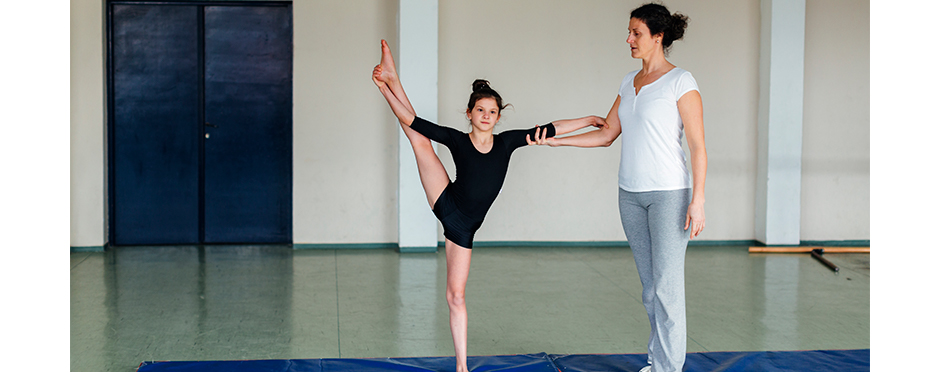
Stretching Safely in Gymnastics
Leave a CommentGymnasts require more flexibility than the general athlete to perform the necessary skills of their sport. Summertime is a great time to focus on increasing flexibility. Since stretching is an important component of training, it is a good idea to review some of the safest ways to stretch to prevent injury and progress flexibility.
Types of Stretches
- Static Stretching
Static stretching is what many people commonly think of when you say “stretching.” With this type of stretch, a position is held with the muscle on tension to a point of a stretching sensation. This position is held for a longer length of time.2 Static stretching has shown to be effective for increasing joint range of motion. Stretches with between 10-30 seconds of holding time is sufficient for this improvement in joint range.2
- Dynamic Stretching
Dynamic stretching can also be termed “active stretching” and is when a limb is moving through its full range of motion to end ranges and repeated several times.2 Dynamic stretching has also been shown to be effective for increasing joint range of motion.
- Ballistic Stretching
Ballistic stretching is when there is “bouncing” at the end range of motion. Due to an increased risk of injury, ballistic stretching is no longer recommended.1
When Should Gymnasts Stretch?
Stretching for gymnasts should take place at both the start and end of practice. When practice is starting, gymnasts should do a little cardiovascular warm-up, such as jumping jacks or running around the floor for five minutes, to warm up the muscles prior to stretching. An overall warm up that is specific to the sport is also important prior to the start of practice.
Stretching after practice or after a meet is also important for injury prevention and should be included as part of a cool down.
When to Perform Static vs. Dynamic Stretching
Static stretching prior to a workout or competition has been shown to be detrimental in some cases.2,3 Post-stretching strength deficits have been found after static stretching in athletes for running and vertical jump height. 2,3 Therefore, dynamic stretching within a sport-specific warm up is ideal prior to workouts or competitions. If static stretching is performed during a warm up, only short hold durations should be performed. An example of some dynamic stretching warm-ups for a gymnast could include arm and wrist circles, leg kicks forward/backward/side, lunges and trunk twisting exercises.
Static stretching can be added into a cool down or after a workout. This type of stretching is ideal when the muscles are warm and can help with overall flexibility, which is very important for gymnasts. Static stretching examples for gymnasts include splits, straddles, pikes and bridges. The gymnast wants to make sure they stretch their hamstrings, quadriceps, hip flexors, calves and shoulders.
Stretching for the Splits
Performing the splits is a large part of gymnastics and is required for a variety of skills. When stretching for the splits, it is important to remember to do all directions – right, left and center – and not to focus on only one direction. Remember not to bounce when doing these stretches. Stretching should be gentle and the gymnast should go slow and not push into a painful range. Flexibility is not gained overnight, so to see progress in splits the athlete needs to be consistent with stretching over several weeks. Also, as mentioned previously, stretches should be held for around 30 seconds and then take a break and should be performed after a warm up.
Oversplits
Oversplits are when the athlete has already attained the splits in all directions (Right, left and center) and is ready to start progressing into greater ranges. For those who aren’t familiar, oversplits are splits that go beyond 180 degrees (above the hips) and are usually achieved by stretching in a split with a leg supported by pillows, blocks or chairs. Keep in mind that gymnasts should not “hang” in this position, but should have part of their body supported to decrease the risk of injury. It is extremely important that someone working toward oversplits spends time on strengthening and stabilizing the hips and core of the body so they have control over this large range of motion when they try to use it during practice.
Stretching For Flexibility
All stretching should be gentle and pain free. Do not push yourself into a painful range as this can cause the muscle to contract to protect itself and is counterproductive to stretching for flexibility. Instead, gradually progress your stretches by starting in a gentle range and go just to the point of slight discomfort. Great care should be taken to avoid pain; having others push you into a stretch is dangerous as they do not know where you feel the stretch and this could lead to injuries.
As always, should an injury occur during stretching or another activity, schedule an appointment at a nearby Athletico so our clinicians can help you heal and get back to doing the things you love.
The Athletico blog is an educational resource written by Athletico employees. Athletico bloggers are licensed professionals who abide by the code of ethics outlined by their respective professional associations. The content published in blog posts represents the opinion of the individual author based on their expertise and experience. The content provided in this blog is for informational purposes only, does not constitute medical advice and should not be relied on for making personal health decisions.
References:
1. Medicine ACoS ACSM’s guidelines for exercise testing and prescription. 7th ed. Baltimore: Lippincot Williams Wilkins; 2006
2. Page P. CURRENT CONCEPTS IN MUSCLE STRETCHING FOR EXERCISE AND REHABILITATION. International Journal of Sports Physical Therapy. 2012;7(1):109-119.
3. Samson M, Button DC, Chaouachi A, Behm DG. Effects of Dynamic and Static Stretching Within General and Activity Specific Warm-Up Protocols. Journal of Sports Science & Medicine. 2012;11(2):279-285.
